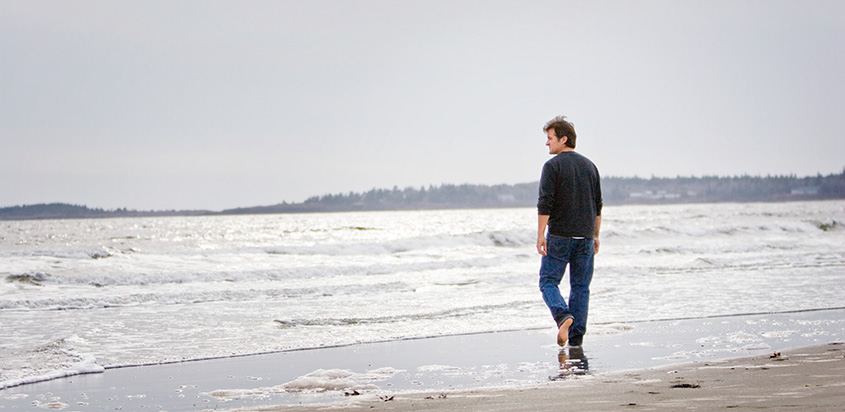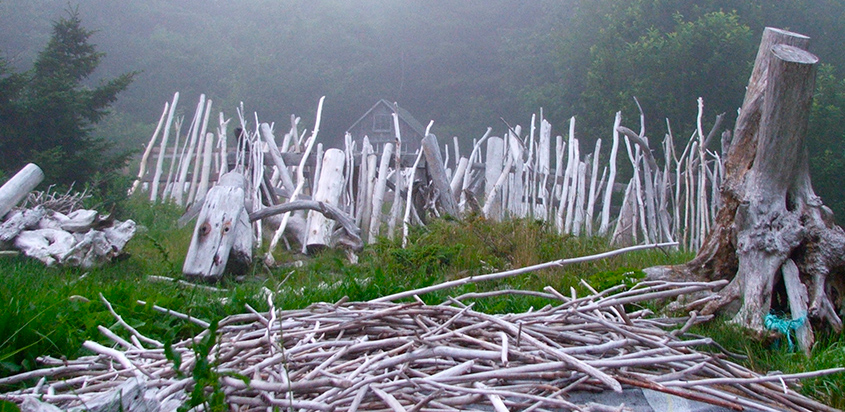Process
The Search
 The environment I often find myself in is ever changing. It is both beautiful and dramatic-—like the material I am searching for.
The environment I often find myself in is ever changing. It is both beautiful and dramatic-—like the material I am searching for.
I walk for hours – combing, turning, lifting, hauling, carrying – searching for just the right piece – a selected piece, not simply any piece.
My decisions are based more on aesthetics than the critical consideration of its suitability. My love of its color, shape and texture are what drive me, sometimes to great lengths – sometimes with heroic strength…
Each piece has a story.
A piece may show itself resting on a rock ledge or hidden beneath a storm-strewn bounty of seaweed, shells, and sea made wood.
Pieces seem to jump out at me.
Driftwood holds an unmistakable natural beauty-—a beauty formed through the Earth’s elements and time…
There is a sensuality within this found wood. It’s silvery finish, luxuriously tactile textures, and organic form appeal to all our senses.
Searching the Maine coast not only puts me in touch with my chosen material, it also reminds me of the importance that we all must remember to, ‘tread lightly.’
It goes beyond simply walking the beach. It’s a respect for the environment from which it has been not only formed, but found.
It is a search for an incredibly finished and uniquely formed natural material found only through a discerning eye and determination.
I must work with the ever changing environment I place myself in; through careful consideration of tides, weather, seasons and accessibility.
The search is where it begins.
The Curing

While the organic shape of driftwood draws me in, it’s the color, tones and textures that attract me.
The elements have created the form, I only wish to utilize the effects of the sun, rain, and wind a little longer…
Whether I leave a piece in the environment in which I found it, or haul it back with me, curing allows each piece to obtain it’s full color and textural potential.
I continually look after each piece until the desired brilliance is achieved. Whether the piece be lying just outside my shop, or if I must hike to it…simply turning, and keeping an eye on the subtle color changes is what I do.
This wood is unlike any other. It is not milled or harvested.
It is a found wood, naturally formed, and finished over time through exposure to outdoor elements.
This often overlooked resource is given a second life.
A bed becomes a statement, polished smooth by waves, as if crafted by the sea itself. A lamp take’s on a life of it’s own from the twisting, knotted shape of a well-worn tree limb. A mirror becomes an ‘objet d’art’, delicately poised on an easel of silvery driftwood.
It is certainly an unhurried process.
The Assemblage

Heidi Kirn Photography
As I lug, carry, drag – whatever it takes – the newly found materials home, I begin thinking of the possibilities for what may become of each piece.
The assemblage begins as a thought, shows itself in a sketch, yet ultimately creates itself.
My materials are naturally whitened branches, trunks, roots, twigs, and sticks – bits and pieces of what was once a tree…
Scouring the beaches and lakes of Maine, I am inspired.
Some pieces are so beautifully crafted by nature’s hand they are sculptures on their own.
Others when combined with copper, steel, glass, seagrass or natural textiles such as linen or cotton, come together to form interesting and one-of-kind furnishings, kinetic yet calming assemblages, or a mixture of both.
All works, whether seen as furniture or art are made from this naturally cured and found material-driftwood.
Whether it be custom furniture pieces, or functional art, I purposefully utilize the contrasting or complimenting colors, tones and textures of each piece, while also considering the form each has taken. Objects, such as my sculptures, require little of my assistance.
Each piece of driftwood has it’s own shape, color, and texture and when combined must compliment each other, it’s not as simple as it may appear.
When building a driftwood chair, the first question is what type of chair am I to build?
Then the choice as to which branch or stick will work best? Many considerations come into play.
The same can be said of all assemblages – there must be consistency with tones, tactile attributes, and thicknesses among all pieces to make it work.
This often overlooked resource is given a second life.
 Michael Fleming Designs Adrift | Maine Driftwood Art & Furniture
Michael Fleming Designs Adrift | Maine Driftwood Art & Furniture